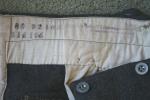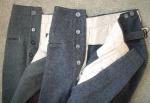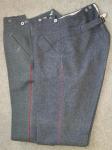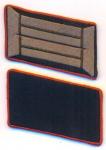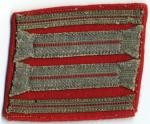-
Posts
2,962 -
Joined
-
Last visited
Content Type
Profiles
Forums
Blogs
Gallery
Events
Store
Everything posted by Chip
-

Tuchhosen
Chip replied to Chip's topic in Germany: Imperial Uniforms, Headwear, Insignia & Personal Equipment
The markings of the M07/10/15 gray pair. No issue stamps, just sizes and a faint manufacturer mark. These were never sent to a Bekleidungsamt. -

Tuchhosen
Chip replied to Chip's topic in Germany: Imperial Uniforms, Headwear, Insignia & Personal Equipment
-

Tuchhosen
Chip replied to Chip's topic in Germany: Imperial Uniforms, Headwear, Insignia & Personal Equipment
This picture shows the front fly. Notice the horn buttons on the 1912 dated trousers and the zink buttons on the later model. -

Tuchhosen
Chip posted a topic in Germany: Imperial Uniforms, Headwear, Insignia & Personal Equipment
For those collectors of WWI German feldgrau material, one of the illusive components for completing a uniform is the trousers. Original pieces are as scarce as the proverbial hen's teeth and in Europe, the prices have surpassed that of the tunics in some cases. Many collectors have not ever seen an original issue pair and it is usually only the "old timer" collectors that have such pieces, as the scarcity and price prohibits newer collectors from acquiring them. I thought I might show a few of the pairs that I have managed to find in order to help those who have not seen original pieces. When talking about these trousers, I will be referring to feldgrau/grau versions only. There were, of course, the graugr?n wool uniforms worn by the J?ger, Sch?tzen, J?ger zu Pferde, and others. Except for the color of the wool and the piping color, these trousers were more or less identical in manufacture to their feldgrau counterparts. I will be discussing the basic infantry style trousers and will leave the other trouser variations (Reithosen, Stiefelhosen, Gebirgshosen, etc.) for later threads. Starting in 1907 with the adoption of the feldgrau (and graugr?n) field uniform, the matching trousers were also made from the same feldgrau base cloth. They had red piping on the side seams, originally from the top of waistband down to the pant cuff. In 1910 this piping was reduced and rather than starting on the waistband, it began 2-3cm below the front pockets. Also in 1910, the top waist closure button, which had been made from horn (like all of the fly and pocket buttons) was changed to zink. These shallow zink dish buttons had been used for the suspender (Hosentr?ger) attachments since 1907 and were situated on the waistband, two pairs in the front and two pairs in the back. By 1914 it had become apparent that the feldgrau cloth of the trousers was fading more quicky than the tunics, due to wear and therefore tended to no longer match the color of the tunic. These varying degrees of fading made for a mottly, undesirable look, which prompted the decision to change the color of the trousers to a more gray color (the so-called Steingrau), which clearly contrasted with the Feldrock. Samples of the new material was stipulated in the late summer of 1914, but the Probe pieces for new colored trousers were not submitted until September 21, 1915. The Bavarian king was not well pleased with the new gray color and therefore ordered (AE from March 31, 1916) a return to the feldgrau cloth. This order, however, turned out to be more of a wish than reality, as economic reasons forced the gray trousers to continue to be made for Bavarian troops. By the beginning of 1917 there began to be difficulties in the procurement of the gray cloth. Hense, light gray overcoat wool and the heavier tunic cloth were used to make trousers. As the supplies of the gray cloth ran out, the manufacture of the trousers of this color were finally put aside. On November 14, 1917 it was again ordered to use feldgrau and graugr?n cloth for the making of trousers. Remaining unissued stocks of the gray trousers were ordered to be set aside for use with the dress peace uniform (Friedensuniform) and were to be used for the field only in case of a dire emegency. It is interesting to note that the red piped trousers were apparenty never specifically ordered to be discontinued, though it seems clear that unpiped versions were issued. For comparison, I am showing two pairs of trousers. The bottom pair is feldgrau and dated 1912. It correctly has the 1910 addition of the zink waist closure button. The other pair is undated and has only manufacturer and size markings. It is made from the gray wool cloth that replaced the feldgrau in 1915. The gray wool of the second pair is what I would call later war, due to its "hairy" appearance caused by the mixture of substitue materials with the wool. These synthetic and reprocessed materials were intended to extend use of the dwindling wool supplies. This gray cloth is very different from the hard finish of the earlier quality wool.. It is nearly identical to the wool on a pair of 1917 dated Stiefelhosen that I will show later. This pair has zink fly buttons, which also is a later war manufacturing change. I would date this pair to the late 1917, early 1918 period and due to the unissued condition, they may well be from some of the last stocks of gray trousers that were held back for dress use. This information is based upon the work of J?rgen Kraus in his book "Die feldgrauen Uniformierung des deutschen Heeres 1907-1918". -

Spange
Chip replied to Chip's topic in Germany: Imperial: The Orders, Decorations and Medals of The Imperial German States
What a beutiful bar! Thanks for showing it. Along with the Luftkrieg bar, I got six other examples from this medal, all different. Chip -
Beau, Beautiful pieces indeed! I think these boards could also be worn by a general who was "a' la suite" to the regiment or a retired general, who was allowed to wear the uniform of choice, often his original regiment. Perhaps someone else can verify this. I have a similar piece from the Hessian I.R.116. Chip
-

Imperial Belt Buckles
Chip replied to Steve K.'s topic in Germany: Imperial Uniforms, Headwear, Insignia & Personal Equipment
Chris, No question about the top one. The bottom one looks like a private purchase piece from front, because of coppery color of the body, but the back looks more like that of an issue piece. I'd guess private purchase if I had to guess. Nice buckles, by-the-way! Chip -
Chris, Prior to 1907, I believe all of the Bavarian infantry regiments wore red straps. With the adoption of the new uniforms, the piping colors representing the prewar strap colors were changed for Bavarian infantry units. The pipings began to be color coded by army corps, so that the straps from the I.b.A.K. had white piping (and underlay), II.b.A.K. had red piping and the III.b.A.K. had yellow piping. To confuse things a little further, the same is true of the Bavarian field artillery units, that is, pre-war - all red straps, after 1907 - corps colors. Since the Bavarian FAR did not use the flaming bomb device on their boards, there are many similarities with the infantry. So, your #9 officer boards could be infantry or artillery! With red underlay they could date anywhere from 1888-1915 The Prussian boards are most likely from the Fu?artillerie Rgt. Nr.6. All foot artillery boards were white on the Dunkelblau tunic. There was no Garde Gren.Rgt.Nr.6. They could be a post 1915 pair for the Friedensuniform, but don't really look like that to me. So I guess if they were M15s for the Friendsuniform, they could be Gren.Rgt.Nr.6 or some other reserve infantry unit. Chip
-

Not a jaeger?
Chip replied to Chris Boonzaier's topic in Germany: Imperial Uniforms, Headwear, Insignia & Personal Equipment
Mike, You would be correct for the peacetime Bavarian Luftschiffer or Telegraphentruppen, but the Bavarian Verkehrstruppen had two tunics, one with Litzen, the so-called Friedensgarnitur and one without Litzen, the Kriegsgarnitur. This would be the field uniform version, without the Litzen. Here is a circa 1912 uniform plate which shows the difference. The Bavarians did not adopt the light gray shoulder strap piping until the spring of 1914. Chip -

Not a jaeger?
Chip replied to Chris Boonzaier's topic in Germany: Imperial Uniforms, Headwear, Insignia & Personal Equipment
Chris, I would guess he is from the Telegraphentruppen or maybe the Luftschiffertruppen. The ammo pouches are typical of the Verkehrstruppen and the French rifle would also indicate a non-front line contingent. The straps appear to have light colored piping, which would have been light gray for the aforementioned units. Chip -
Claudius, Nice devices. I think the reason you did not get any comment right away might be because this thread was concerning collar Litzen and your additions didn't really follow the theme. At least one of your items, the oak leaves, is not from the period. No harm done obviously, but I found it to be a bit curious Best regards, Chip




